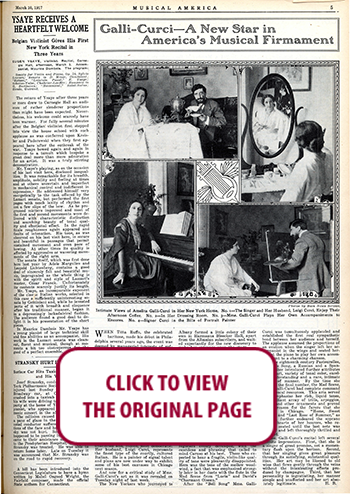 100 YEARS AGO IN MUSICAL AMERICA (186)
100 YEARS AGO IN MUSICAL AMERICA (186)
March 10, 1917
Page 5
Galli-Curci—A New Star in America’s Musical Firmament
WHEN Titta Ruffo, the celebrated baritone, made his debut in Philadelphia several years ago, the event was deemed by managerial interests of sufficient importance to charter a special train so that certain New York newspapermen, musical managers and others might attend. The incident was recalled on Tuesday night of last week when a party of New Yorkers, all impressed by the sensational reports that had come from Chicago regarding Mme. Amelita Galli-Curci’s phenomenal voice and coloratura singing, made their way to Albany, where in Harmanus Bleecker Hall the Italian songstress was scheduled to make her first appearance in the East, barring a recital in Buffalo a fortnight ago.
A word first about Mme. Galli-Curci’s personality and appearance. She is slightly over medium height, of a rather slender build and not unlike the great Pavlowa in facial expression. Those who had the opportunity of meeting her after the concert found her to be vivacious, unaffected and, indeed, most democratic. Her husband, Luigi Curci, represents the finest type of the courtly, cultured Italian. He is a painter of signal talent and plans are now under way to exhibit some of his best canvases in Chicago next season.
And now for a critical study of Mme. Galli-Curci’s art as it was revealed on Tuesday night of last week.
The New Yorkers who journeyed to Albany formed a little colony of their own in Harmanus Bleecker Hall, apart from the Albanian subscribers, and waited expectantly for the new discovery to make her entrance upon the stage.
She entered, bowed gracefully and waited for the applause to subside. Exquisitely gowned, stately and refined in carriage, she struck a sympathetic chord in the hearts of the audience before she sang her first note. The opening measures of “Caro mio ben” revealed a warm, liquid tone of remarkable purity that grew in smoothness and steadiness as the singer gained her composure. There was nothing dazzling or bewildering in her singing as yet. It was intensely satisfying and, above all, pleasurable.
The promises held forth in her early songs were realized, however, after Mme. Galli-Curci had finished the “Bell Song” from “Lakmé.” Here was a singer for whom the coloratura style seemed a natural form of expression. It was not the puppet-like soprano planted on the stage and commanded to reveal her bag of tricks. It was the singing of a musician, well grounded in the technique of her art, with lower and upper registers evenly developed, with the cantilena and phrasing that called to mind Caruso at his best. Those who expected to hear a fragile, violin-like quality of tone were pleasantly disappointed. Hers was the tone of the mellow woodwind, a fact that was emphasized strongly later in her duets with the flute in the Mad Scene from “Lucia” and David’s “Charmant Oiseau.”
After the “Bell Song” Mme. Galli-Curci was tumultuously applauded and established the first real sympathetic bond between her audience and herself. The applause assumed the proportions of an ovation when the singer left her accompanist in the wings and seated herself at the piano to play her own accompaniment to a charming chanson.
A few eighteenth century Pastourelles, Solveig’s Song, a Russian and a Spanish number introduced further attributes of her art, variety of tonal color, excellent understanding and a rare, intimate charm of manner. By the time she reached the final number, the Mad Scene, Mme. Galli-Curci had complete command of her vocal resources. This aria served to re-emphasize her rich, liquid tones, the brilliant array of trills, arpeggios, scales and other ornaments and proved ample reason for the furore that she created in Chicago. “Home, Sweet Home,” and “Last Rose of Summer,” as encores, further endeared the soprano to the hearts of her hearers, who remained seated until the last note was finished and left thoroughly thrilled and satisfied.
Mme. Galli-Curci’s recital left several definite impressions. First, that she is a singer of great promise, not a momentary flash upon the horizon. Second that her singing gives great pleasure through its satisfying, substantial qualities. Her art may be likened to old wine that flows gently through the veins without the intoxicating effects .produced by champagne. Third, that her personality is ingratiating, her manner simple and unaffected and her art absolutely legitimate. —H. B.




 RENT A PHOTO
RENT A PHOTO





